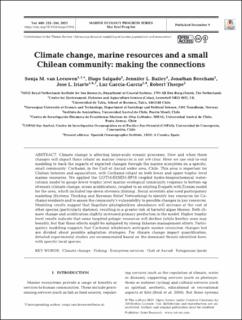| dc.contributor.author | van Leeuwen, Sonja M. | |
| dc.contributor.author | Salgado, Hugo | |
| dc.contributor.author | Bailey, Jennifer L. | |
| dc.contributor.author | Beecham, Jonathan | |
| dc.contributor.author | Iriarte, José L. | |
| dc.contributor.author | García-García, Luz | |
| dc.contributor.author | Thorpe, Robert | |
| dc.date.accessioned | 2022-02-11T13:19:30Z | |
| dc.date.available | 2022-02-11T13:19:30Z | |
| dc.date.created | 2021-12-15T16:10:08Z | |
| dc.date.issued | 2021 | |
| dc.identifier.citation | Marine Ecology Progress Series. 2021, 680 223-246. | en_US |
| dc.identifier.issn | 0171-8630 | |
| dc.identifier.uri | https://hdl.handle.net/11250/2978506 | |
| dc.description.abstract | Climate change is affecting large-scale oceanic processes. How and when these changes will impact those reliant on marine resources is not yet clear. Here we use end-to-end modeling to track the impacts of expected changes through the marine ecosystem on a specific, small community: Cochamó, in the Gulf of Ancud wider area, Chile. This area is important for Chilean fisheries and aquaculture, with Cochamó reliant on both lower and upper trophic level marine resources. We applied the GOTM-ERSEM-BFM coupled hydro-biogeochemical watercolumn model to gauge lower-trophic level marine ecological community response to bottom-up stressors (climate change, ocean acidification), coupled to an existing Ecopath with Ecosim model for the area, which included top-down stressors (fishing). Social scientists also used participatory modeling (Systems Thinking and Bayesian Belief Networking) to identify key resources for Cochamó residents and to assess the community’s vulnerability to possible changes in key resources. Modeling results suggest that flagellate phytoplankton abundance will increase at the cost of other species (particularly diatoms), resulting in a greater risk of harmful algae blooms. Both climate change and acidification slightly increased primary production in the model. Higher trophic level results indicate that some targeted pelagic resources will decline (while benthic ones may benefit), but that these effects might be mitigated by strong fisheries management efforts. Participatory modeling suggests that Cochamó inhabitants anticipate marine ecosystem changes but are divided about possible adaptation strategies. For climate change impact quantification, detailed experimental studies are recommended based on the dominant threats identified here, with specific local species. | en_US |
| dc.language.iso | eng | en_US |
| dc.publisher | Inter Research | en_US |
| dc.rights | Navngivelse 4.0 Internasjonal | * |
| dc.rights.uri | http://creativecommons.org/licenses/by/4.0/deed.no | * |
| dc.title | Climate change, marine resources and a small Chilean community: making the connections | en_US |
| dc.type | Peer reviewed | en_US |
| dc.type | Journal article | en_US |
| dc.description.version | publishedVersion | en_US |
| dc.source.pagenumber | 223-246 | en_US |
| dc.source.volume | 680 | en_US |
| dc.source.journal | Marine Ecology Progress Series | en_US |
| dc.identifier.doi | 10.3354/meps13934 | |
| dc.identifier.cristin | 1969064 | |
| cristin.ispublished | true | |
| cristin.fulltext | original | |
| cristin.qualitycode | 2 | |

